Two Mw ≥ 6.5 Earthquakes in Central Pamir Constrained by Satellite SAR Observations
Abstract
:1. Introduction
2. Coseismic Surface Deformation
2.1. Data Processing
2.2. Coseismic Surface Observations
3. Inversion Methods and Results
3.1. Coseismic Deformation Downsampling
3.2. Location and Geometry of Seismogenic Faults
3.3. Distributed Slip Models
4. Discussion
4.1. Comparison to Different Slip Models
4.2. Implications for Seismic Hazards along the SKFS Zone
4.3. Potential Role of SKFS in Regional Tectonics
5. Conclusions
Author Contributions
Funding
Data Availability Statement
Acknowledgments
Conflicts of Interest
References
- Burtman, V.S.; Molnar, P. Geological and geophysical evidence for deep sub-duction of continental crust beneath the Pamir. Spec. Pap. Geol. Soc. Am. 1993, 281, 1–76. [Google Scholar]
- Cowgill, E. Cenozoic right-slip faulting along the eastern margin of the Pamir salient, northwestern China. Geol. Soc. Am. Bull. 2010, 122, 145–161. [Google Scholar] [CrossRef]
- Fu, B.; Ninomiya, Y.; Guo, J. Slip partitioning in the northeast Pamir-Tian Shan convergence zone. Tectonophysics 2010, 483, 344–364. [Google Scholar] [CrossRef]
- Schwab, M.; Ratschbacher, L.; Siebel, W.; McWilliams, M.; Minacv, V.; Lutkov, V.; Chen, F.; Stanek, K.; Nelson, B.; Frisch, W.; et al. Assembly of the Pamirs: Age and origin of magmatic belts from the southern Tien Shan to the southern Pamirs and their relation to Tibet. Tectonics 2004, 23, TC4002. [Google Scholar] [CrossRef]
- Sun, J.; Xiao, W.; Windley, B.F.; Ji, W.; Fu, B.; Wang, J.; Jin, C. Provenance change of sediment input in the northeastern foreland of Pamir related to collision of the Indian Plate with the Kohistan-Ladakh arc at around 47 Ma. Tectonics 2016, 35, 315–338. [Google Scholar] [CrossRef]
- Mechie, J.; Yuan, X.; Schurr, B.; Schneider, F.; Sippl, C.; Ratschbacher, L.; Minaev, V.; Gadoev, M.; Oimahmadov, I.; Abdybachaev, U.; et al. Crustal and uppermost mantle velocity structure along a profile across the Pamir and southern Tien Shan as derived from project TIPAGE wide-angle seismic data. Geophys. J. Int. 2012, 188, 385–407. [Google Scholar] [CrossRef]
- Schmidt, J.; Hacker, B.R.; Ratschbacher, L.; Stubner, K.; Stearns, M.; Kylander-Clark, A.; Cottle, J.M.; Alexander, A.; Webb, G.; Gehrels, G.; et al. Cenozoic deep crust in the Pamir. Earth Planet. Sci. Lett. 2011, 312, 411–421. [Google Scholar] [CrossRef]
- Li, W.; Chen, Y.; Yuan, X.; Schurr, B.; Mechie, J.; Oimahmadov, I.; Fu, B. Continental lithospheric subduction and intermediate-depth seismicity: Constraints from S-wave velocity structures in the Pamir and Hindu Kush. Earth Planet. Sci. Lett. 2018, 482, 478–489. [Google Scholar] [CrossRef]
- Zubovich, A.V.; Wang, X.Q.; Scherba, Y.G.; Schelochkov, G.G.; Reilinger, R.; Reigber, C.; Mosienko, O.I.; Molnar, P.; Michajljow, W.; Makarov, V.I.; et al. GPS velocity field for the Tien Shan and surrounding regions. Tectonics 2010, 29, TC6014. [Google Scholar] [CrossRef]
- Ischuk, A.; Bendick, R.; Rybin, A.; Molnar, P.; Khan, F.S.; Kuzikov, S.; Zubovich, A.V. Kinematics of the Pamir and Hindu Kush regions from GPS geodesy. J. Geophys. Res. Solid Earth 2013, 118, 2408–2416. [Google Scholar] [CrossRef]
- Reigber, C.; Michel, G.W.; Galas, R.; Angermann, D.; Klotz, J.; Chen, J.Y.; Ishanov, M.C. New space geodetic constraints on the distribution of deformation in Central Asia. Earth Planet. Sci. Lett. 2001, 191, 157–165. [Google Scholar] [CrossRef]
- Mohadjer, S.; Bendick, R.; Ischuk, A.; Kuzikov, S.; Kostuk, A.; Saydullaev, U.; Lodi, S.; Kakar, D.M.; Wasy, A.; Khan, M.A.; et al. Partitioning of India-Eurasia convergence in the Pamir-Hindu Kush from GPS measurements. Geophys. Res. Lett. 2010, 37, L04305. [Google Scholar] [CrossRef]
- Sippl, C.; Schurr, B.; Yuan, X.; Mechie, J.; Schneider, F.M.; Gadoev, M.; Radjabov, N. Geometry of the Pamir-Hindu Kush intermediate-depth earthquake zone from local seismic data. J. Geophys. Res. Solid Earth 2013, 118, 1438–1457. [Google Scholar] [CrossRef]
- Mohadjer, S.; Ehlers, T.A.; Bendick, R.; Stübner, K.; Strube, T. A Quaternary fault database for central Asia. Nat. Hazard Earth Syst. 2016, 16, 529–542. [Google Scholar] [CrossRef]
- Zhou, Y.; He, J.; Oimahmadov, I.; Gadoev, M.; Pan, Z.; Wang, W.; Rajabov, N. Present-day crustal motion around the Pamir Plateau from GPS measurements. Gondwana Res. 2016, 35, 144–154. [Google Scholar] [CrossRef]
- Nikolaev, V. Afghan-Tajik depression: Architecture of sedimentary cover and evolution. Russ. J. Earth Sci. 2002, 4, 399–421. [Google Scholar] [CrossRef]
- Schurr, B.; Ratschbacher, L.; Sippl, C.; Gloaguen, R.; Yuan, X.; Mechie, J. Seismotectonics of the Pamir. Tectonics 2014, 33, 1501–1518. [Google Scholar] [CrossRef]
- Stübner, K.; Ratschbacher, L.; Rutte, D.; Stanek, K.; Minaev, V.; Wiesinger, R.; Project TIPAGE Members. The giant Shakhdara migmatitic gneiss dome, Pamir, India-Asia collision zone. 1: Geometry and kinematics. Tectonics 2013, 32, 948–979. [Google Scholar] [CrossRef]
- Rutte, D.; Ratschbacher, L.; Schneider, S.; Stübner, K.; Stearns, M.A.; Gulzar, M.A.; Hacker, B.R. Building the Pamir-Tibet Plateau-Crustal stacking, extensional collapse, and lateral extrusion in the Central Pamir: 1. Geometry and kinematics. Tectonics 2017, 36, 342–384. [Google Scholar] [CrossRef]
- Strecker, M.R.; Frisch, W.; Hamburger, M.W.; Ratschbacher, L.; Semiletkin, S.; Zamoruyev, A.; Sturchio, N. Quaternary deformation in the Eastern Pamirs, Tadzhikistan and Kyrgyzstan. Tectonics 1995, 14, 1061–1079. [Google Scholar] [CrossRef]
- Sippl, C.; Schurr, B.; Tympel, J.; Angiboust, S.; Mechie, J.; Yuan, X.; Schneider, F.M.; Sobolev, S.V.; Ratschbacher, L.; Haberland, C.; et al. Deep burial of Asian continental crust beneath the Pamir imaged with local earthquake tomography. Earth Planet. Sci. Lett. 2013, 384, 165–177. [Google Scholar] [CrossRef]
- Schneider, F.M.; Yuan, X.; Schurr, B.; Mechie, J.; Sippl, C.; Haberland, C.; Negmatullaev, S. Seismic imaging of subducting continental lower crust beneath the Pamir. Earth Planet. Sci. Lett. 2013, 375, 101–112. [Google Scholar] [CrossRef]
- Bostock, M.G. The Moho in subduction zones. Tectonophysics 2013, 609, 547–557. [Google Scholar] [CrossRef]
- Ambraseys, N.; Bilham, R. The Sarez-Pamir earthquake and landslide of 18 February 1911. Seismol. Res. Lett. 2012, 83, 294–314. [Google Scholar] [CrossRef]
- Kulikova, G.; Schurr, B.; Krüger, F.; Brzoska, E.; Heimann, S. Source parameters of the Sarez-Pamir earthquake of 1911 February 18. Geophys. J. Int. 2016, 205, 1086–1098. [Google Scholar] [CrossRef]
- Elliott, A.; Elliott, J.; Hollingsworth, J.; Kulikova, G.; Parsons, B.; Walker, R. Satellite imaging of the 2015 M7.2 earthquake in the Central Pamir, Tajikistan, elucidates a sequence of shallow strike-slip ruptures of the Sarez-Karakul fault. Geophys. J. Int. 2020, 221, 1696–1718. [Google Scholar] [CrossRef]
- Metzger, S.; Schurr, B.; Ratschbacher, L.; Sudhaus, H.; Kufner, S.-K.; Schöne, T.; Bendick, R. The 2015 Mw7.2 Sarez strike-slip earthquake in the Pamir interior: Response to the underthrusting of India’s western promontory. Tectonics 2017, 36, 2407–2421. [Google Scholar] [CrossRef]
- Sangha, S.; Peltzer, G.; Zhang, A.; Meng, L.; Liang, C.; Lundgren, P.; Fielding, E. Fault geometry of 2015, Mw7. 2 Murghab, Tajikistan earthquake controls rupture propagation: Insights from InSAR and seismological data. Earth Planet. Sci. Lett. 2017, 462, 132–141. [Google Scholar] [CrossRef]
- Jin, Z.; Fialko, Y.; Zubovich, A.; Schöne, T. Lithospheric deformation due to the 2015 M7. 2 Sarez (Pamir) earthquake constrained by 5 years of space geodetic observations. J. Geophys. Res. Solid Earth 2022, 127, e2021JB022461. [Google Scholar] [CrossRef]
- Shi, Y.; Wang, Y.; Bian, Y. Coseismic Source Model of the February 2023 Mw 6.8 Tajikistan Earthquake from Sentinel-1A InSAR Observations and Its Associated Earthquake Hazard. Remote Sens. 2023, 15, 3010. [Google Scholar] [CrossRef]
- Massonnet, D.; Rossi, M.; Carmona, C.; Adragna, F.; Peltzer, G.; Feigl, K.; Rabaute, T. The displacement field of the Landers earthquake mapped by radar interferometry. Nature 1993, 364, 138–142. [Google Scholar] [CrossRef]
- Werner, C.; Wegmuller, U.; Strozzi, T.; Wiesmann, A. GAMMA SAR and interferometric processing software. In Proceedings of the ERS ENVISAT Symposium, Gothenburg, Sweden, 16–20 October 2001. [Google Scholar]
- Goldstein, R.M.; Werner, C.L. Radar interferogram filtering for geophysical applications. Geophys. Res. Lett. 1998, 25, 4035–4038. [Google Scholar] [CrossRef]
- Chen, C.W.; Zebker, H.A. Network approaches to two-dimensional phase unwrapping: Intractability and two new algorithms. J. Opt. Soc. Am. 2000, 17, 401–414. [Google Scholar] [CrossRef]
- Yu, C.; Li, Z.; Penna, N.T. Interferometric synthetic aperture radar atmospheric correction using a GPS-based iterative tropospheric decomposition model. Remote Sens. Environ. 2008, 204, 109–121. [Google Scholar] [CrossRef]
- Yu, C.; Li, Z.; Penna, N.T.; Crippa, P. Generic atmospheric correction model for interferometric synthetic aperture radar observations. J. Geophys. Res. Solid Earth 2018, 123, 9202–9222. [Google Scholar] [CrossRef]
- Cavalié, O.; Doin, M.P.; Lasserre, C.; Briole, P. Ground motion measurement in the Lake Mead area, Nevada, by differential syn- thetic aperture radar interferometry time series analysis: Probing the lithosphere rheological structure. J. Geophys. Res. 2007, 112, B03403. [Google Scholar] [CrossRef]
- Michel, R.; Avouac, J.P.; Taboury, J. Measuring ground displacements from SAR amplitude images: Application to the Landers earthquake. Geophys. Res. Lett. 1999, 26, 875–878. [Google Scholar] [CrossRef]
- De Zan, F. Accuracy of incoherent speckle tracking for circular Gaussian signals. IEEE Geosci Remote Sens. Lett. 2014, 11, 264–267. [Google Scholar] [CrossRef]
- Wang, S.; Song, C.; Li, S.S.; Li, X. Resolving co- and early post-seismic slip variations of the 2021 MW 7.4 Madoi earthquake in east Bayan Har block with a block-wide distributed deformation mode from satellite synthetic aperture radar data. Earth Planet. Phys. 2022, 6, 108–122. [Google Scholar] [CrossRef]
- Jónsson, S.; Segall, P.; Pedersen, R.; Björnsson, G. Post-earthquake ground movements correlated to pore-pressure transients. Nature 2003, 424, 179–183. [Google Scholar] [CrossRef]
- Simons, M.; Fialko, Y.; Rivera, L. Coseismic deformation from the 1999 M w 7.1 Hector Mine, California, earthquake as inferred from InSAR and GPS observations. Bull. Seismol. Soc. Am. 2002, 92, 1390–1402. [Google Scholar] [CrossRef]
- Wang, K.; Fialko, Y. Slip model of the 2015 Mw 7.8 Gorkha (Nepal) earthquake from inversions of ALOS-2 and GPS data. Geophys. Res. Lett. 2015, 42, 7452–7458. [Google Scholar] [CrossRef]
- Wang, K.; Bürgmann, R. Co-and early postseismic deformation due to the 2019 Ridgecrest earthquake sequence constrained by Sentinel-1 and COSMO-SkyMed SAR data. Seismol. Res. Lett. 2020, 91, 1998–2009. [Google Scholar] [CrossRef]
- Bagnardi, M.; Hooper, A. Inversion of surface deformation data for rapid estimates of source parameters and uncertainties: A Bayesian approach. Geochem. Geophys. Geosyst. 2018, 19, 2194–2211. [Google Scholar] [CrossRef]
- Okada, Y. Internal deformation due to shear and tensile faults in a half-space. Bull. Seismol. Soc. Am. 1992, 82, 1018–1040. [Google Scholar] [CrossRef]
- Wang, S.; Jiang, G.; Lei, X.; Barbour, A.J.; Tan, X.; Xu, C.; Xu, X. Three Mw ≥ 4.7 earthquakes within the Changning (China) shale gas field ruptured shallow faults intersecting with hydraulic fracturing wells. J. Geophys. Res. Solid Earth 2022, 127, e2021JB022946. [Google Scholar] [CrossRef]
- Stark, P.B.; Parker, R.L. Bounded-variable least-squares: An algorithm and applications. Comput. Stat. 1995, 10, 129. [Google Scholar]
- Wang, S.; Xu, C.J.; Wen, Y.M.; Yin, Z.; Jiang, G.Y.; Fang, L.H. Slip model for the 25 November 2016 Mw 6.6 Aketao earthquake, western China, revealed by Sentinel-1 and ALOS-2 observations. Remote Sens. 2017, 9, 325. [Google Scholar] [CrossRef]
- Wang, S.; Jiang, G.Y.; Weingarten, M.; Niu, Y.F. InSAR evidence indicates a link between fluid injection for salt mining and the 2019 Changning (China) earthquake sequence. Geophys. Res. Lett. 2020, 47, e2020GL087603. [Google Scholar] [CrossRef]
- Wang, S.; Xu, W.B.; Xu, C.J.; Yin, Z.; Bürgmann, R.; Liu, L.; Jiang, G.Y. Changes in groundwater level possibly encourage shallow earthquakes in central Australia: The 2016 Petermann Ranges earthquake. Geophys. Res. Lett. 2019, 46, 3189–3198. [Google Scholar] [CrossRef]
- Walters, R.J.; Gregory, L.C.; Wedmore, L.N.; Craig, T.J.; McCaffrey, K.; Wilkinson, M.; Vittori, E. Dual control of fault intersections on stop-start rupture in the 2016 Central Italy seismic sequence. Earth Planet. Sci. Lett. 2018, 500, 1–14. [Google Scholar] [CrossRef]
- Luo, Y.; Ampuero, J.P. Stability of faults with heterogeneous friction properties and effective normal stress. Tectonophysics 2018, 733, 257–272. [Google Scholar] [CrossRef]
- Wang, Z.; Zhang, W.; Taymaz, T.; He, Z.; Xu, T.; Zhang, Z. Dynamic rupture process of the 2023 Mw 7.8 Kahramanmaraş earthquake (SE Türkiye): Variable rupture speed and implications for seismic hazard. Geophys. Res. Lett. 2023, 50, e2023GL104787. [Google Scholar] [CrossRef]
- Jia, Z.; Jin, Z.; Marchandon, M.; Ulrich, T.; Gabriel, A.A.; Fan, W.; Fialko, Y. The complex dynamics of the 2023 Kahramanmaraş, Turkey, M w 7.8-7.7 earthquake doublet. Science 2023, 381, 985–990. [Google Scholar] [CrossRef]
- Sieh, K.; Jones, L.; Hauksson, E.; Hudnut, K.; Eberhart-Phillips, D.; Heaton, T. Near-field investigations of the Landers earthquake sequence, April to July 1992. Science 1993, 260, 171–176. [Google Scholar] [CrossRef]
- Jónsson, S.; Zebker, H.; Segall, P.; Amelung, F. Fault slip distribution of the 1999 Mw 7.1 Hector Mine, California, earthquake, estimated from satellite radar and GPS measurements. Bull. Seismol. Soc. Am. 2002, 92, 1377–1389. [Google Scholar] [CrossRef]
- Xu, W.; Feng, G.; Meng, L.; Zhang, A.; Ampuero, J.P.; Bürgmann, R.; Fang, L. Transpressional rupture cascade of the 2016 Mw 7.8 Kaikoura earthquake, New Zealand. J. Geophys. Res. Solid Earth 2018, 123, 2396–2409. [Google Scholar] [CrossRef]
- Feng, W.; Samsonov, S.; Qiu, Q.; Wang, Y.; Zhang, P.; Li, T.; Zheng, W. Orthogonal fault rupture and rapid postseismic deformation following 2019 Ridgecrest, California, earthquake sequence revealed from geodetic observations. Geophys. Res. Lett. 2020, 47, e2019GL086888. [Google Scholar] [CrossRef]
- Jin, Z.; Fialko, Y. Finite slip models of the 2019 Ridgecrest earthquake sequence constrained by space geodetic data and aftershock locations. Bull. Seismol. Soc. Am. 2020, 110, 1660–1679. [Google Scholar] [CrossRef]
- Taufiqurrahman, T.; Gabriel, A.A.; Li, D.; Ulrich, T.; Li, B.; Carena, S.; Gallovič, F. Dynamics, interactions and delays of the 2019 Ridgecrest rupture sequence. Nature 2023, 618, 308–315. [Google Scholar] [CrossRef]
- Toda, S.; Stein, R.S.; Richards-Dinger, K.; Bozkurt, S.B. Forecasting the evolution of seismicity in southern California: Animations built on earthquake stress transfer. J. Geophys. Res. 2005, 110, B05S16. [Google Scholar] [CrossRef]
- Lin, J.; Stein, R.R. Stress triggering in thrust and subduction earthquakes, and stress interaction between the southern San Andreas and nearby thrust and strike-slip faults. J. Geophys. Res. 2004, 109, B02303. [Google Scholar] [CrossRef]
- Fan, G.; Ni, J.F.; Wallace, T.C. Active tectonics of the Pamirs and Karakorum. J. Geophys. Res. Solid Earth 1994, 99, 7131–7160. [Google Scholar] [CrossRef]
- Kufner, S.-K.; Schurr, B.; Sippl, C.; Yuan, X.H.; Ratschbacher, L.; Akbar, A.S.M.; Ischuk, A.; Murodkulov, S.; Schneider, F.; Mechie, J.; et al. Deep India meets deep Asia: Lithospheric indentation, delamination and break-off under Pamir and Hindu Kush (Central Asia). Earth Planet. Sci. Lett. 2016, 435, 171–184. [Google Scholar] [CrossRef]
- He, P.; Hetland, E.A.; Niemi, N.A.; Wang, Q.; Wen, Y.; Ding, K. The 2016 Mw 6.5 Nura earthquake in the Trans Alai range, northern Pamir: Possible rupture on a back-thrust fault constrained by Sentinel-1A radar interferometry. Tectonophysics 2018, 749, 62–71. [Google Scholar] [CrossRef]
- Kufner, S.-K.; Schurr, B.; Ratschbacher, L.; Murodkulov, S.; Abdulhameed, S.; Ischuk, A.; Metzger, S.; Kakar, N. Seismotectonics of the Tajik basin and surrounding mountain ranges. Tectonics 2018, 37, 2404–2424. [Google Scholar] [CrossRef]
- Wessel, P.; Smith, W.H.F.; Scharroo, R.; Luis, J.; Wobbe, F. Generic mapping tools: Improved version released. Eos Trans. AGU 2013, 94, 409–410. [Google Scholar] [CrossRef]
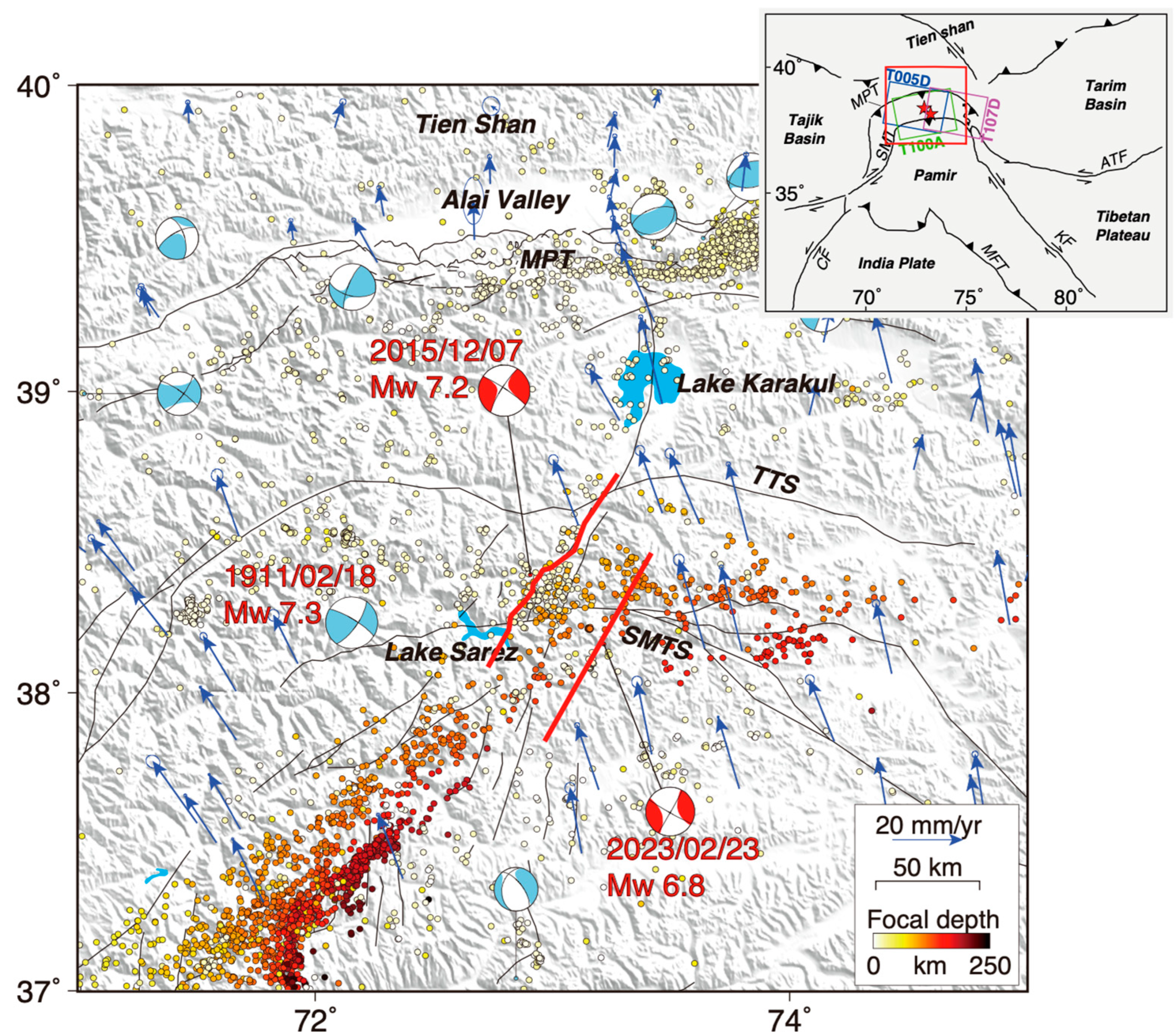

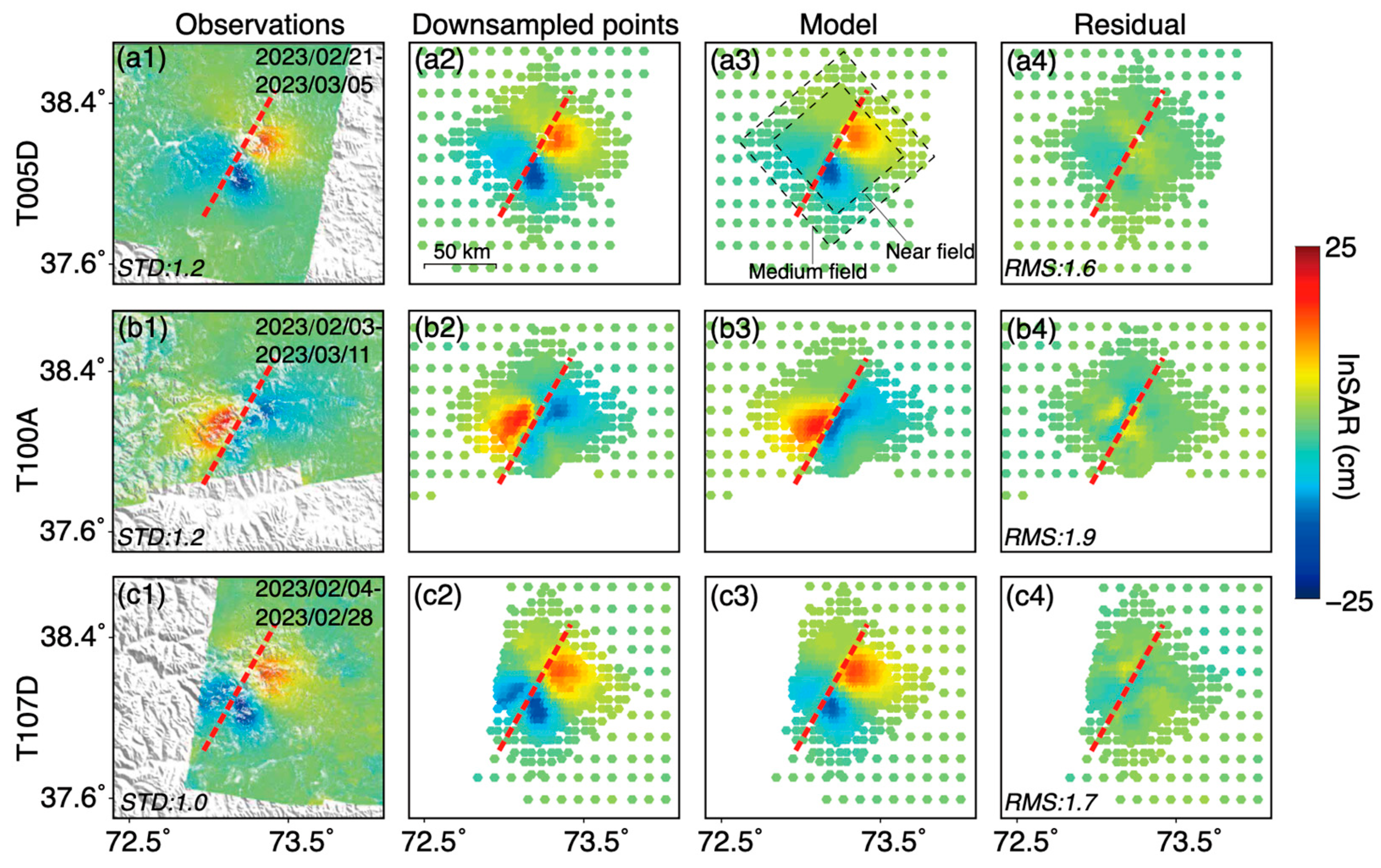
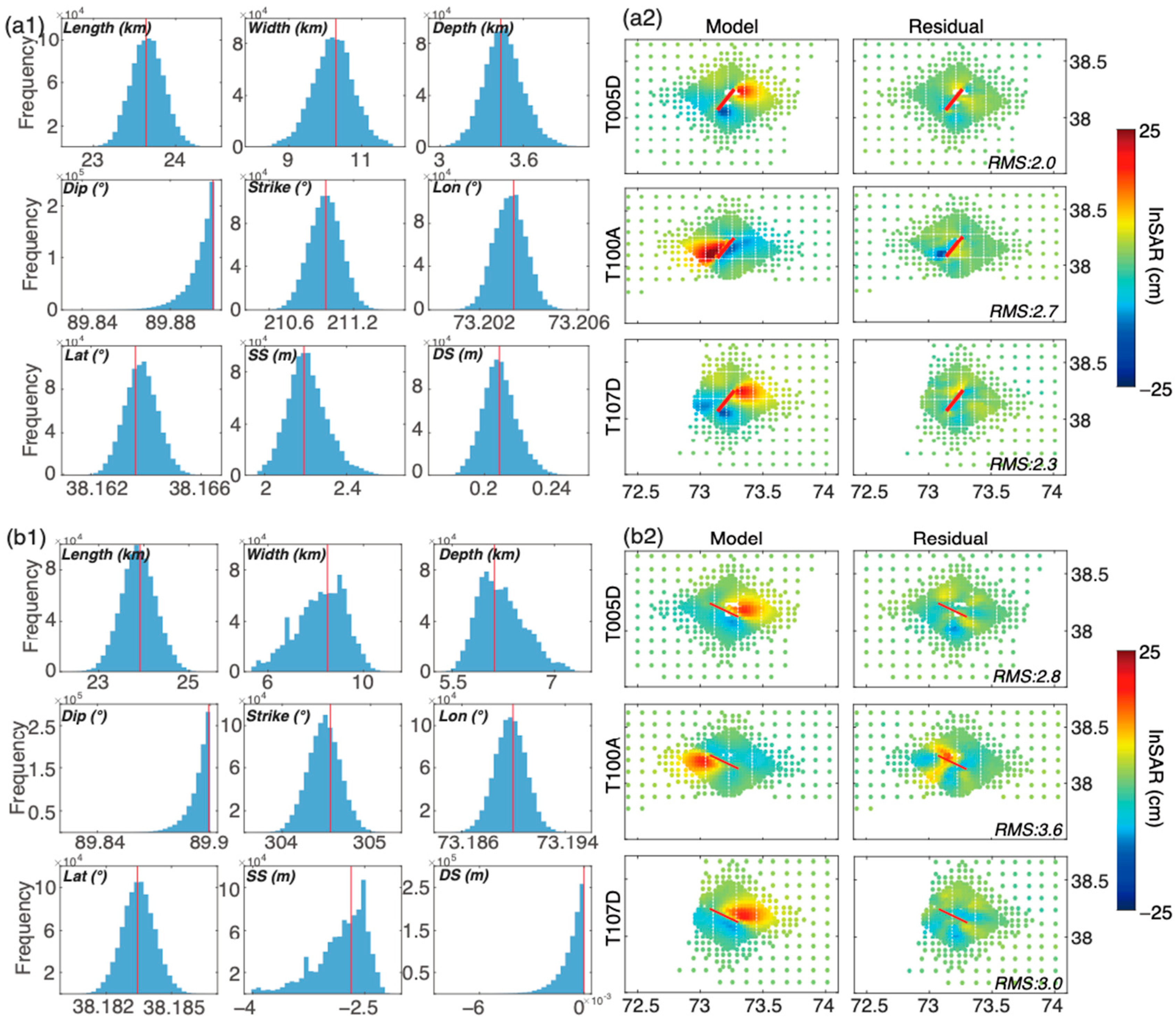
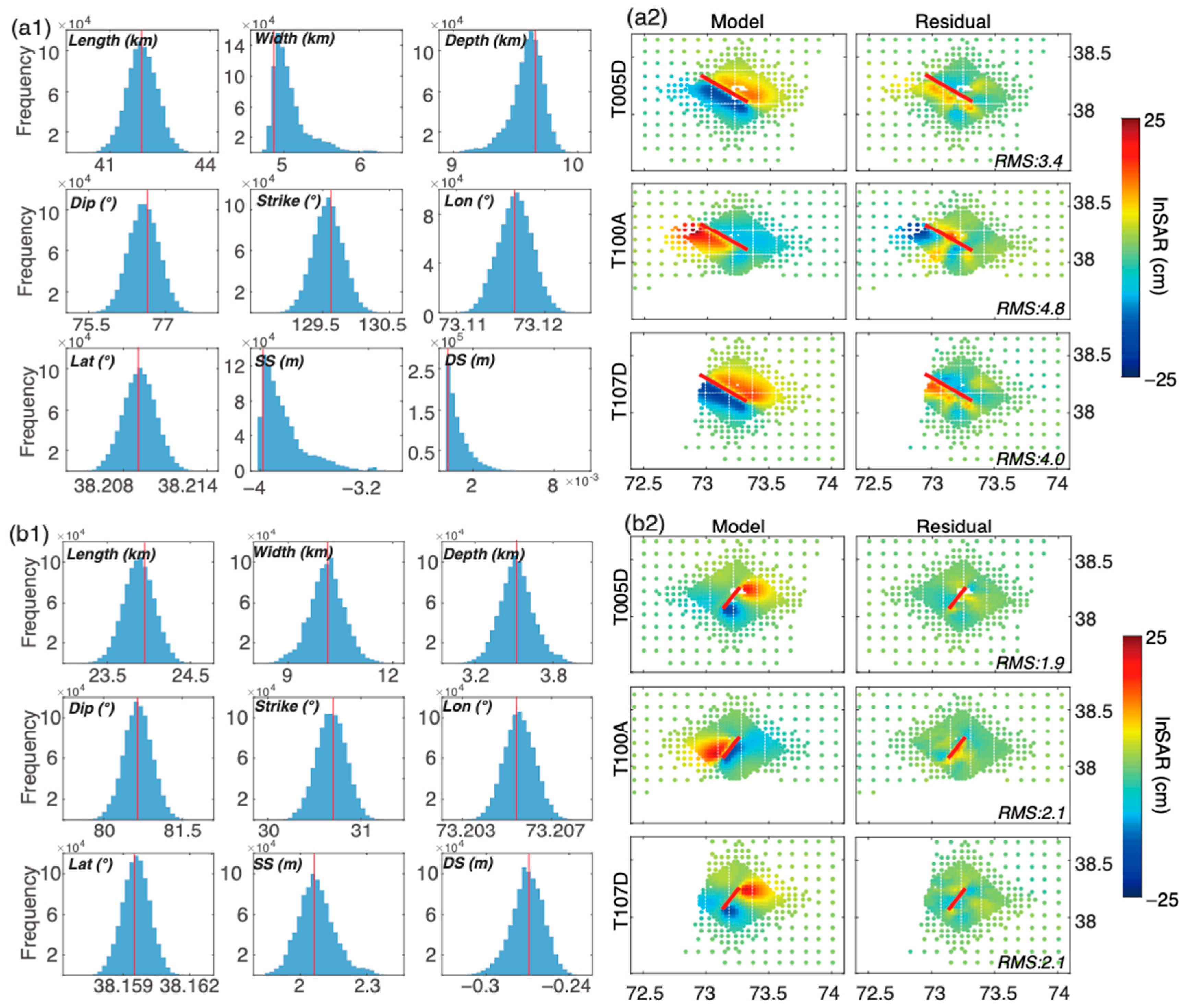
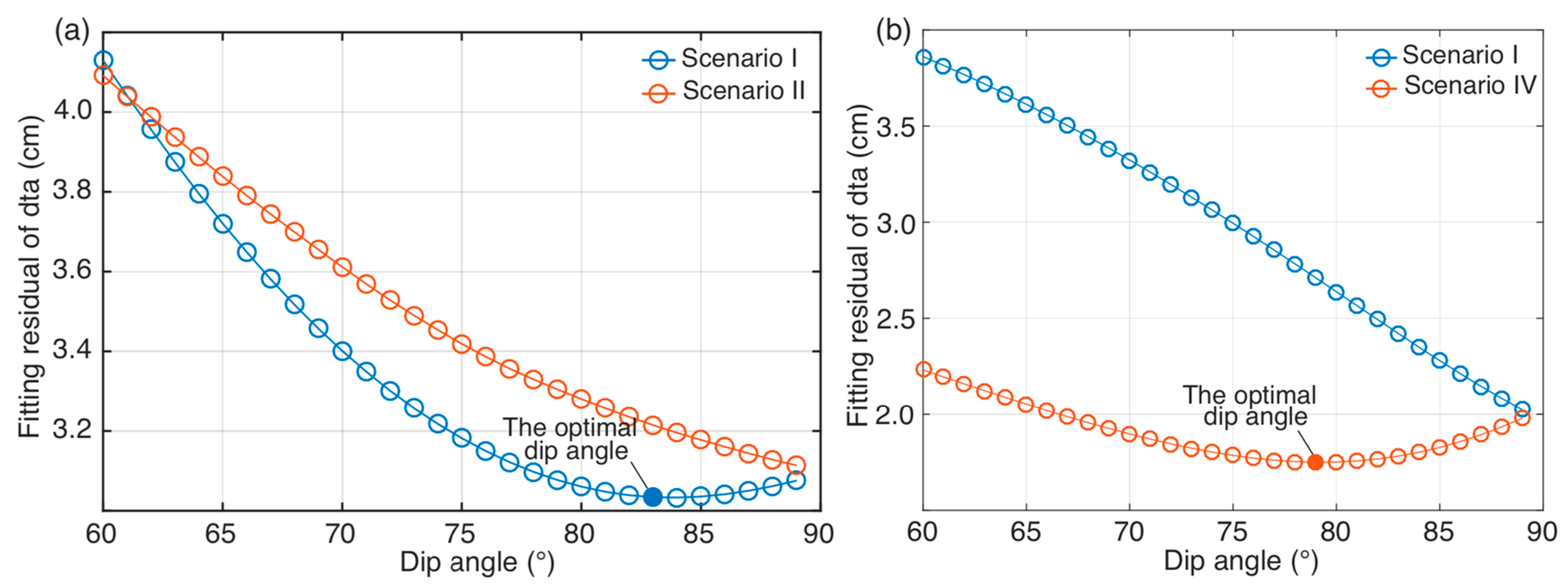
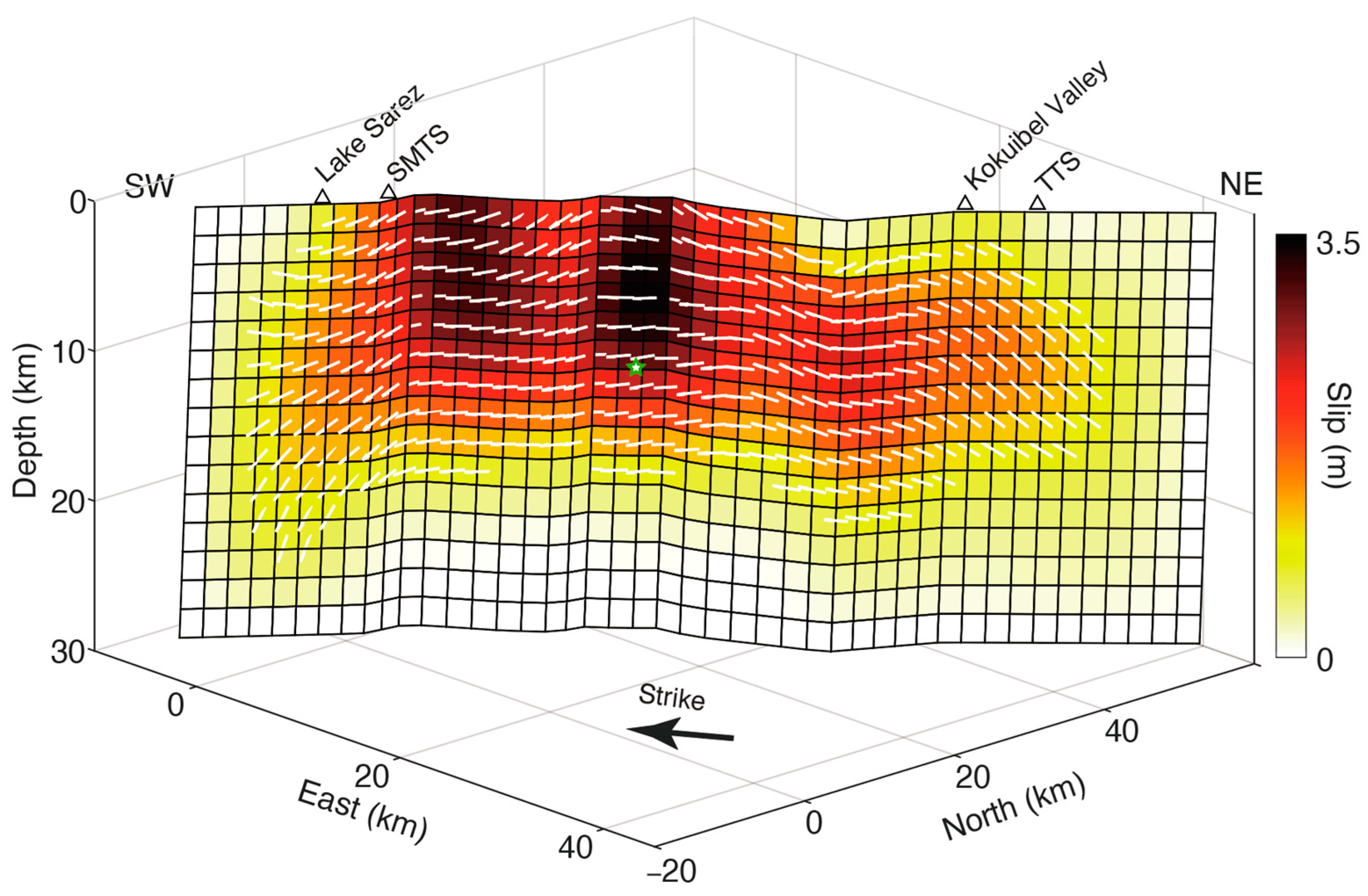
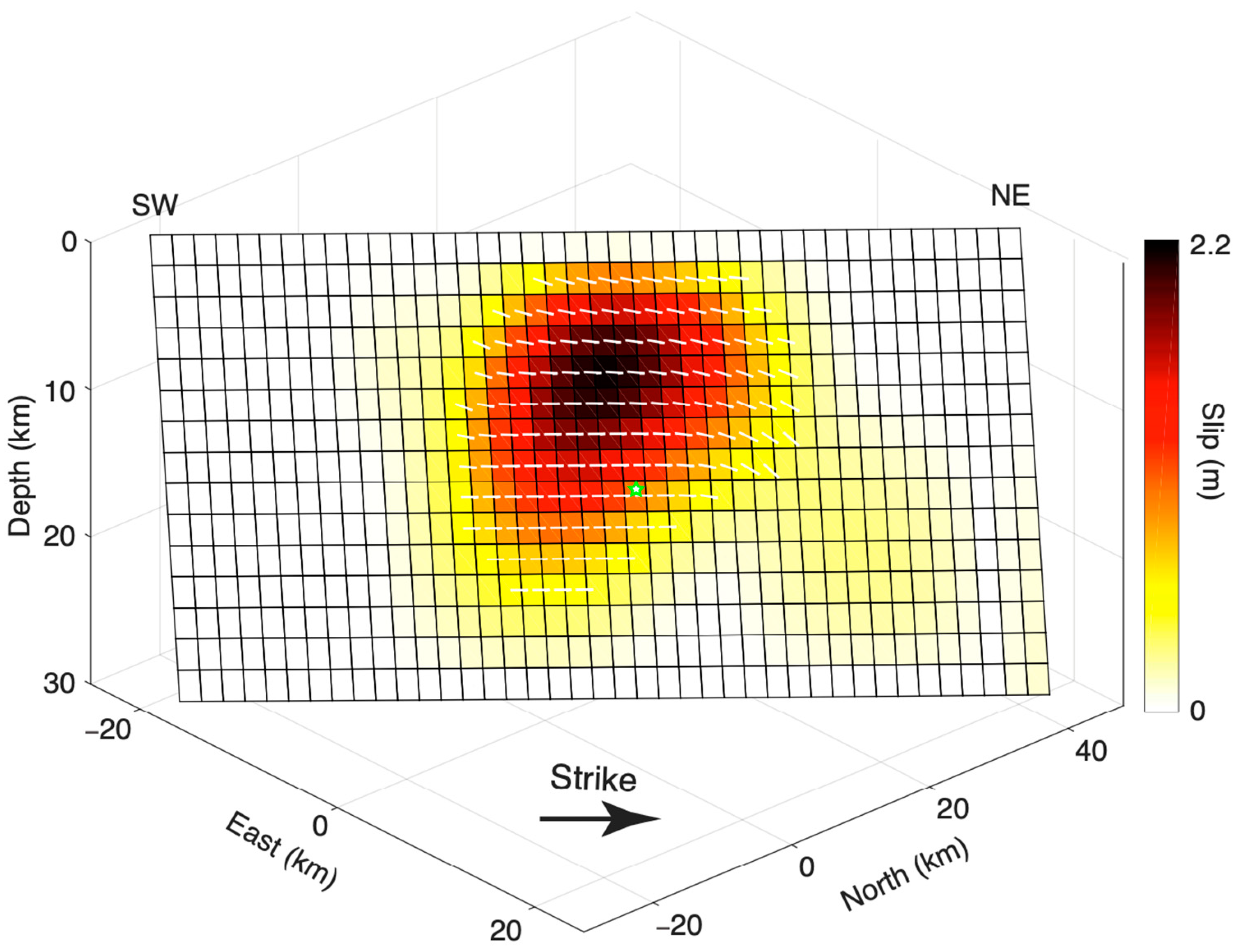

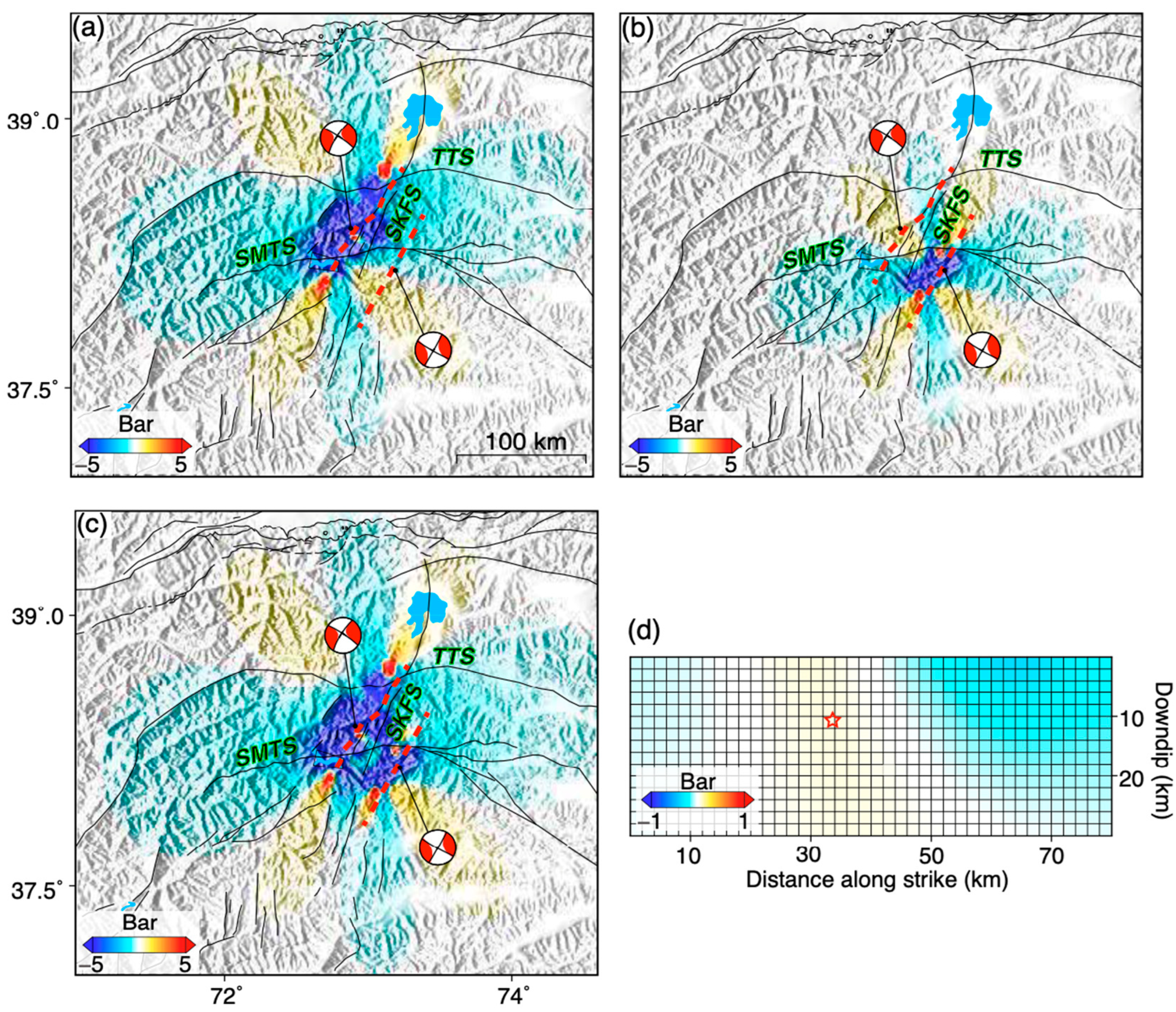
| Event | Def. Type | Track | Reference | Repeat | σ (cm) † |
|---|---|---|---|---|---|
| 7 December 2015 Mw 7.2 | Range offset | 5 (Descending) | 20151118 | 20151212 | 66.9 |
| 100 (Ascending) | 20151206 | 20151230 | 77.4 | ||
| InSAR | 5 (Descending) | 20151118 | 20151212 | 2.3 | |
| 100 (Ascending) | 20151206 | 20151230 | 2.9 | ||
| 107 (Descending) | 20151207 | 20151231 | 1.8 | ||
| 23 February 2023 Mw 6.8 | InSAR | 5 (Descending) | 20230221 | 20230305 | 1.2 |
| 100 (Ascending) | 20230203 | 20230311 | 1.2 | ||
| 107 (Descending) | 20230204 | 20230228 | 1.0 |
| Event | Lon (°) | Lat (°) | Depth (km) | Mw | Node Plane I | Node Plane II | Source | ||||
|---|---|---|---|---|---|---|---|---|---|---|---|
| Strike (°) | Dip (°) | Rake (°) | Strike (°) | Dip (°) | Rake (°) | ||||||
| 7 December 2015 Mw 7.2 | 72.780 | 38.211 | 19.5 | 7.2 | 214 | 83 | 8 | 123 | 82 | 172 | USGS |
| 72.91 | 38.39 | 12 | 7.2 | 212 | 80 | −7 | 304 | 83 | −170 | GCMT | |
| 72.94 | 38.13 | 11 | 7.2 | 124 | 85 | −161 | 33 | 71 | −4 | GFZ | |
| 23 February 2023 Mw 6.8 | 73.230 | 38.056 | 13.5 | 6.9 | 203 | 57 | −21 | 305 | 72 | −146 | USGS |
| 73.22 | 38.15 | 16.9 | 6.8 | 210 | 88 | 1 | 120 | 89 | 178 | GCMT | |
| 73.29 | 38.06 | 10 | 6.8 | 122 | 73 | −158 | 25 | 67 | −18 | GFZ | |
Disclaimer/Publisher’s Note: The statements, opinions and data contained in all publications are solely those of the individual author(s) and contributor(s) and not of MDPI and/or the editor(s). MDPI and/or the editor(s) disclaim responsibility for any injury to people or property resulting from any ideas, methods, instructions or products referred to in the content. |
© 2023 by the authors. Licensee MDPI, Basel, Switzerland. This article is an open access article distributed under the terms and conditions of the Creative Commons Attribution (CC BY) license (https://creativecommons.org/licenses/by/4.0/).
Share and Cite
Wang, S.; Song, C.; Xiao, Z. Two Mw ≥ 6.5 Earthquakes in Central Pamir Constrained by Satellite SAR Observations. Remote Sens. 2023, 15, 5115. https://doi.org/10.3390/rs15215115
Wang S, Song C, Xiao Z. Two Mw ≥ 6.5 Earthquakes in Central Pamir Constrained by Satellite SAR Observations. Remote Sensing. 2023; 15(21):5115. https://doi.org/10.3390/rs15215115
Chicago/Turabian StyleWang, Shuai, Chuang Song, and Zhuohui Xiao. 2023. "Two Mw ≥ 6.5 Earthquakes in Central Pamir Constrained by Satellite SAR Observations" Remote Sensing 15, no. 21: 5115. https://doi.org/10.3390/rs15215115
APA StyleWang, S., Song, C., & Xiao, Z. (2023). Two Mw ≥ 6.5 Earthquakes in Central Pamir Constrained by Satellite SAR Observations. Remote Sensing, 15(21), 5115. https://doi.org/10.3390/rs15215115







